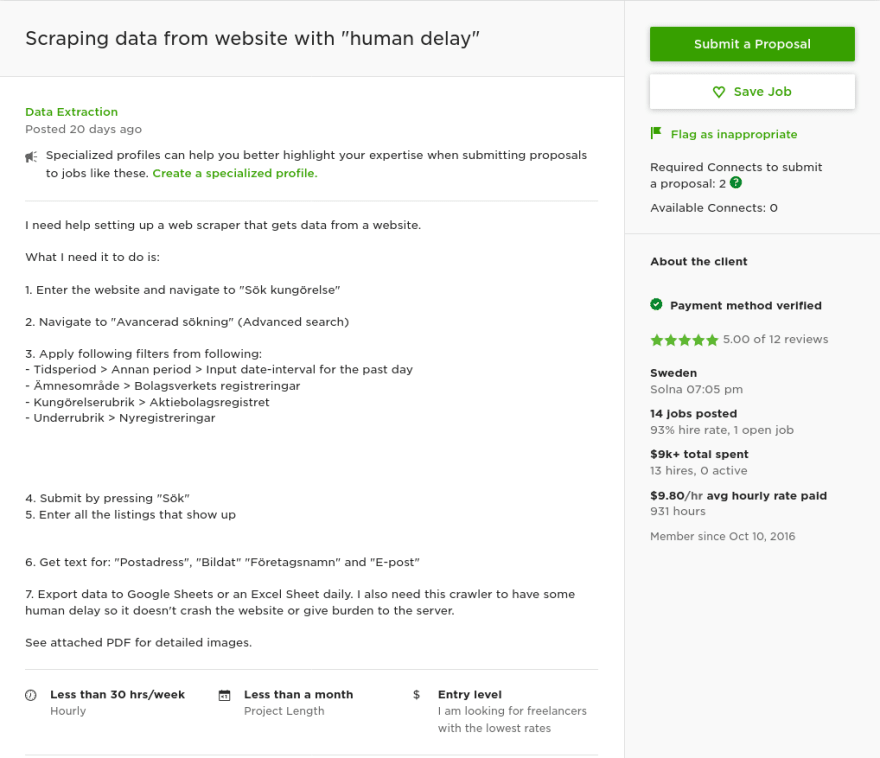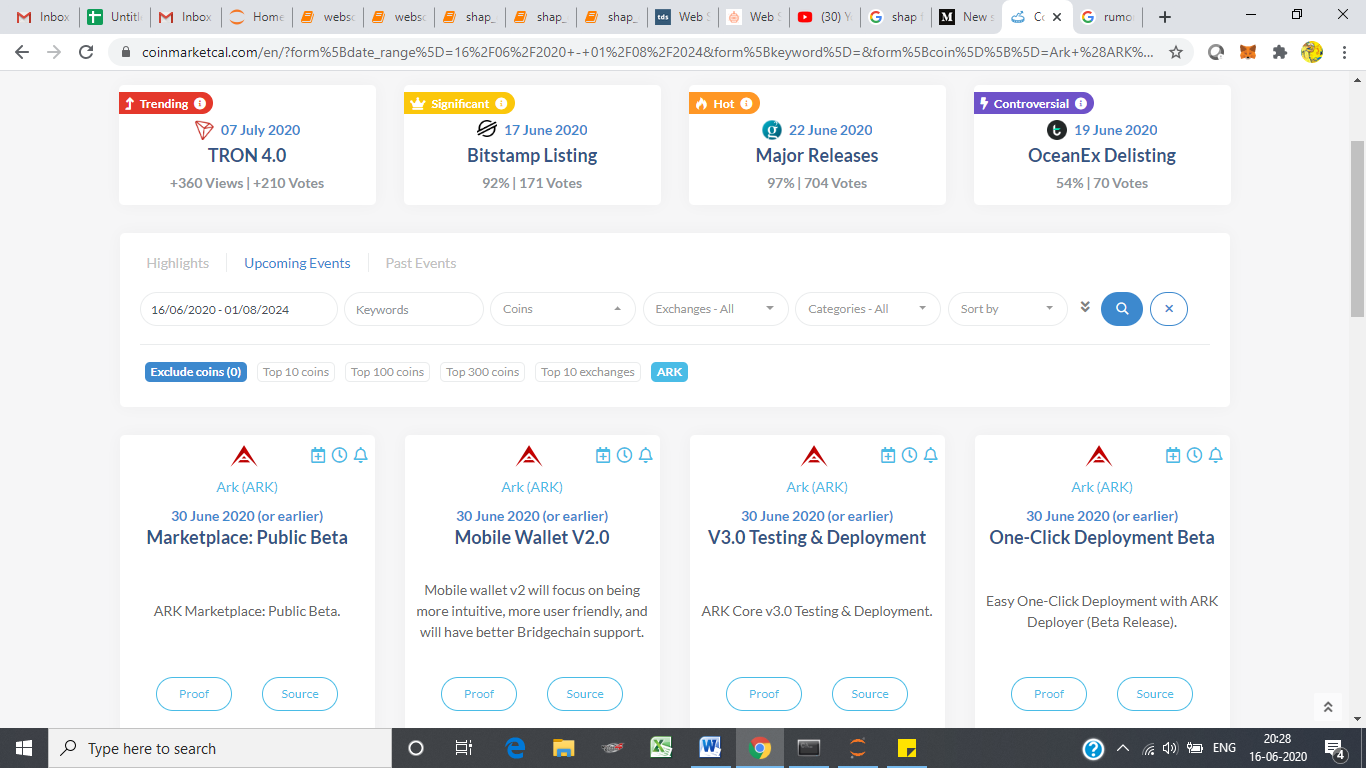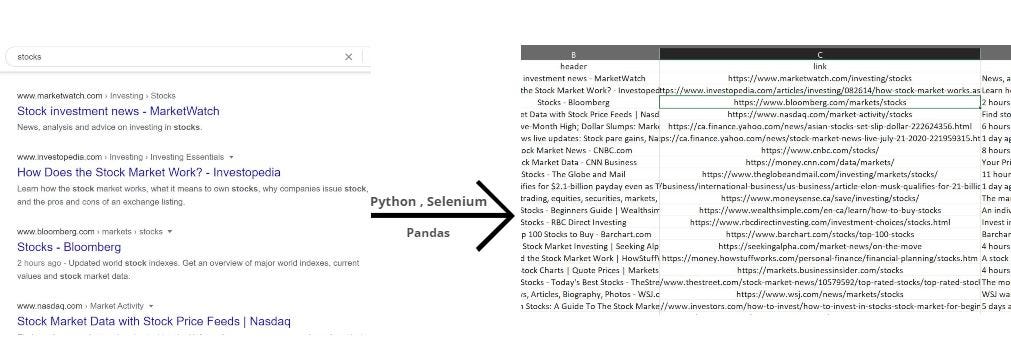Now, the interaction with any web application requires the Selenium driver to identify web elements on the page. Until and unless an element gets correctly identified, it’s impossible to trigger events like click, enter, etc. On any web element. Now to search the web elements, Selenium provides two methods. Web Scraping with Selenium in Headless Mode using the Chrome Web Driver: In this section, I am going to show you an example of web scrapping in Selenium using the Chrome web driver in headless mode. First, visit the random-name-generator.info from Google Chrome or any other web browser. This website will generate 10 random names each time you. Dependson: - 'selenium' environment: - SELENIUMLOCATION=samplecrawlerselenium1 volumes: -.:/myscraper # use this command to keep the container running command: tail -f /dev/null Run docker-compose up -d. If you're doing this the first time it will take a while for it to fetch the latest selenium/standalone-chrome and the build your.
AdvancedWeb scraping is a very useful mechanism to either extract data, or automate actions on websites. Normally we would use urllib or requests to do this, but things start to fail when websites use javascript to render the page rather than static HTML. For many websites the information is stored in static HTML files, but for others the information is loaded dynamically through javascript (e.g. from ajax calls). The reason maybe because the information is constantly changing, or it maybe to prevent webscraping! Either way, you need to more advanced techniques to scrape the information – this is where the library selenium can help.
What is web scraping?
On Example of Scraping with Selenium WebDriver in C#. In this article I will show you how it is easy to scrape a web site using Selenium WebDriver. I will guide you through a sample project which is written in C# and uses WebDriver in conjunction with the Chrome browser to login on the testing page and scrape the text from the private area of the website. This story consists of an introduction to dynamic websites and explains how to do dynamic web scraping for 50000 results. Let’s begin with the introduction to dynamic websites. Dynamic websites.
To align with terms, web scraping, also known as web harvesting, or web data extraction is data scraping used for data extraction from websites. The web scraping script may access the url directly using HTTP requests or through simulating a web browser. The second approach is exactly how selenium works – it simulates a web browser. The big advantage in simulating the website is that you can have the website fully render – whether it uses javascript or static HTML files.
What is selenium?
According to selenium official web page, it is a suite of tools for automating web browsers. This project is a member of the Software Freedom Conservancy, Selenium has three projects, each provides a different functionality if you are interested in it, visit their official website. The scope of this blog will be attached to the Selenium WebDriver project
When should you use selenium?
Selenium is going to facilitate us with tools to perform web scraping, but when should it be used? You generally can use selenium in the following scenarios:
- When the data is loaded dynamically – for example Twitter. What you see in “view source” is different to what you see on the page (The reason is that “view source” just shows the static HTML files. If you want to see under the covers of a dynamic website, right click and “inspect element” instead)
- When you need to perform an interactive action in order to display the data on screen – a classic example is infinite scrolling. For some websites, you need to scroll to the bottom of the page, and then more entries will show. What happens behind the scene is that when you scroll to the bottom, javascript code will call the server to load more records on screen.
So why not use selenium all the time? It is a bit slower then using requests and urllib. The reason is that selenium simulates running a full browser including the overhead that a brings with it. There are also a few extra steps required to use selenium as you can see below.
Once you have the data extracted, you can still use similar approaches to process the data (e.g. using tools such as BeautifulSoup)
Pre-requisites for using selenium
Step 1: Install selenium library
Before starting with a web scraping sample ensure that all requirements have been set, Selenium requires pip or pip3 installed, if you don’t have it installed you can follow the official guide to install it based on the operating system you have.
Once pip is installed you can proceed with the installation of selenium, with the following command
Alternatively, you can download the PyPI source archive (selenium-x.x.x.tar.gz) and install it using setup.py:
Step 2: Install web driver
Selenium simulates an actual browser. It won’t use your chrome installation but it will use a “driver” which is the browser engine to run a browser. Selenium supports multiple web browsers, so you may chose which web browser to use (read on)
Selenium WebDriver refers to both the language bindings and the implementations of the individual browser controlling code. This is commonly referred to as just a web driver.
Web driver needs to be downloaded, and then it could be either added to the path environment variable or initialized with a string containing the path where downloaded web driver is. Environment variables are out of the scope of the blog so we are going to use the second option.
From here to the end Firefox web driver is going to be used, but here is a table containing information regarding each web driver, you are able to choose any of them, Firefox is recommended to follow this blog
Download the driver to a common folder which is accessible. Your script will refer to this driver.
You can follow our guide on how to install the web driver here.
A Simple Selenium Example in Python
Ok, we’re all set. To begin with, let’s start with a quick staring example to ensure things are all working. Our first example will involving collecting a website title. In order to achieve this goal, we are going to use selenium, assuming it is already installed in your environment, just import webdriver from selenium in a python file as it’s shown in the following.
Running the code below will open a firefox window which looks a little bit different as can be seen in the following image and at the then it prints into the console the title of the website, in this case, it is collecting data from ‘Google’. Results should be similar to the following images:
Note that this was run in foreground so that you can see what is happening. Now we are going to manually close the firefox window opened, it was intentionally opened in this way to be able to see that the web driver actually navigates just like a human will do. But now that it is known, we can add at the end of the out this code: driver.quit() so the window will automatically be closed after the job is done. Code now will look like this.

Now the sample will open the Firefox web driver do its jobs and then close the windows. With this little and simple example, we are ready to go dipper and learn with a complex sample
How To Run Selenium in background

In case you are running your environment in console only or through putty or other terminal, you may not have access to the GUI. Also, in an automated environment, you will certainly want to run selenium without the browser popping up – e.g. in silent or headless mode. This is where you can add the following code at the start “options” and “–headless”.
The remaining examples will be run in ‘online’ mode so that you can see what is happening, but you can add the above snippet to help.
Example of Scraping a Dynamic Website in Python With Selenium
Until here, we have figure out how to scrap data from a static website, with a little bit of time, and patience you are now able to collect data from static websites. Let’s now dive a little bit more into the topic and build a script to extract data from a webpage which is dynamically loaded.
Imagine that you were requested to collect a list of YouTube videos regarding “Selenium”. With that information, we know that we are going to gather data from YouTube, that we need the searching result of “Selenium”, but this result will be dynamic and will change all the time.
The first approach is to replicate what we have done with Google, but now with YouTube, so a new file needs to be created yt-scraper.py
Now we are retrieving data YouTube title printed, but we are about to add some magic to the code. Our next step is to edit the search box and fill it with the word that we are looking for “Selenium” by simulating a person typing this into the search. This is done by using the Keys class:
from selenium.webdriver.common.keys import Keys.

The driver.quit() line is going to be commented temporally so we are able to see what we are performing
The Youtube page shows a list of videos from the search as expected!
As you might notice, a new function has been called, named find_element_by_xpath, which could be kind of confusing at the moment as it uses strange xpath text. Let’s learn a little bit about XPath to understand a bit more.
What is XPath?
XPath is an XML path used for navigation through the HTML structure of the page. It is a syntax for finding any element on a web page using XML path expression. XPath can be used for both HTML and XML documents to find the location of any element on a webpage using HTML DOM structure.
The above diagram shows how it can be used to find an element. In the above example we had ‘//input[@id=”search”]. This finds all <input> elements which have an attributed called “id” where the value is “search”. See the image below – under the “inspect element” for the search box from youTube, you can seen there’s a tag <input id=”search” … >. That’s exactly the element we’re searching for with XPath
There are a great variety of ways to find elements within a website, here is the full list which is recommended to read if you want to master the web scraping technique.
Looping Through Elements with Selenium
Now that Xpath has been explained, we are able to the next step, listing videos. Until now we have a code that is able to open https://youtube.com, type in the search box the word “Selenium” and hit Enter key so the search is performed by youtube engine, resulting in a bunch of videos related to Selenium, so let’s now list them.
Firstly, right click and “inspect element” on the video section and find the element which is the start of the video section. You can see in the image below that it’s a <div> tag with “id=’dismissable'”

We want to grab the title, so within the video, find the tag that covers the title. Again, right click on the title and “inspect element” – here you can see the element “id=’video-title'”. Within this tag, you can see the text of the title.
One last thing, let’s remind that we are working with internet and web browsing, so sometimes is needed to wait for the data to be able, in this case, we are going to wait 5 seconds after the search is performed and then retrieve the data we are looking information. Keep in mind that the results could vary due to internet speed, and device performance.
Once the code is executed you are going to see a list printed containing videos collected from YouTube as shown in the following image, which firstly prints the website title, then it tells us how many videos were collected and finally, it lists those videos.
Waiting for 5 seconds works, but then you have to adjust for each internet speed. There’s another mechanism you can use which is to wait for the actual element to be loaded – you can use this a with a try/except block instead.
So instead of the time.sleep(5), you can then replace the code with:
This will wait up to a maximum of 5 seconds for the videos to load, otherwise it’ll timeout
Conclusion
With Selenium you are going to be able to perform endless of tasks, from automation tasks to automate testing, the sky is the limit here, you have learned how to scrape data from static and dynamic websites, performing javascript actions like send some keys like “Enter”. You can also look at BeautifulSoup to extract and search for data next
Subscribe to our newsletter
Get new tips in your inbox automatically. Subscribe to our newsletter!
Beginner's guide to web scraping with python's selenium
In the first part of this series, we introduced ourselves to the concept of web scraping using two python libraries to achieve this task. Namely, requests and BeautifulSoup. The results were then stored in a JSON file. In this walkthrough, we'll tackle web scraping with a slightly different approach using the selenium python library. We'll then store the results in a CSV file using the pandas library.

The code used in this example is on github.
Why use selenium
Selenium is a framework which is designed to automate test for web applications.You can then write a python script to control the browser interactions automatically such as link clicks and form submissions. However, in addition to all this selenium comes in handy when we want to scrape data from javascript generated content from a webpage. That is when the data shows up after many ajax requests. Nonetheless, both BeautifulSoup and scrapy are perfectly capable of extracting data from a webpage. The choice of library boils down to how the data in that particular webpage is rendered.
Other problems one might encounter while web scraping is the possibility of your IP address being blacklisted. I partnered with scraper API, a startup specializing in strategies that'll ease the worry of your IP address from being blocked while web scraping. They utilize IP rotation so you can avoid detection. Boasting over 20 million IP addresses and unlimited bandwidth.
In addition to this, they provide CAPTCHA handling for you as well as enabling a headless browser so that you'll appear to be a real user and not get detected as a web scraper. For more on its usage, check out my post on web scraping with scrapy. Although you can use it with both BeautifulSoup and selenium.
If you want more info as well as an intro the scrapy library check out my post on the topic.
Using this scraper api link and the codelewis10, you'll get a 10% discount off your first purchase!
For additional resources to understand the selenium library and best practices, this article by towards datascience and accordbox.
Setting up
We'll be using two python libraries. selenium and pandas. To install them simply run pip install selenium pandas
In addition to this, you'll need a browser driver to simulate browser sessions.Since I am on chrome, we'll be using that for the walkthrough.
Driver downloads
- Chrome.
Getting started
For this example, we'll be extracting data from quotes to scrape which is specifically made to practise web scraping on.We'll then extract all the quotes and their authors and store them in a CSV file.
The code above is an import of the chrome driver and pandas libraries.We then make an instance of chrome by using driver = Chrome(webdriver)Note that the webdriver variable will point to the driver executable we downloaded previously for our browser of choice. If you happen to prefer firefox, import like so
Main script
On close inspection of the sites URL, we'll notice that the pagination URL isHttp://quotes.toscrape.com/js/page/{{current_page_number}}/
where the last part is the current page number. Armed with this information, we can proceed to make a page variable to store the exact number of web pages to scrape data from. In this instance, we'll be extracting data from just 10 web pages in an iterative manner.
The driver.get(url) command makes an HTTP get request to our desired webpage.From here, it's important to know the exact number of items to extract from the webpage.From our previous walkthrough, we defined web scraping as
This is the process of extracting information from a webpage by taking advantage of patterns in the web page's underlying code.
We can use web scraping to gather unstructured data from the internet, process it and store it in a structured format.
On inspecting each quote element, we observe that each quote is enclosed within a div with the class name of quote. By running the directive driver.get_elements_by_class('quote')we get a list of all elements within the page exhibiting this pattern.
Final step
To begin extracting the information from the webpages, we'll take advantage of the aforementioned patterns in the web pages underlying code.
We'll start by iterating over the quote elements, this allows us to go over each quote and extract a specific record.From the picture above we notice that the quote is enclosed within a span of class text and the author within the small tag with a class name of author.
Finally, we store the quote_text and author names variables in a tuple which we proceed to append to the python list by the name total.
Using the pandas library, we'll initiate a dataframe to store all the records(total list) and specify the column names as quote and author.Finally, export the dataframe to a CSV file which we named quoted.csv in this case.
Don't forget to close the chrome driver using driver.close().
Adittional resources
1. finding elements
You'll notice that I used the find_elements_by_class method in this walkthrough. This is not the only way to find elements. This tutorial by Klaus explains in detail how to use other selectors.
2. Video
If you prefer to learn using videos this series by Lucid programming was very useful to me.https://www.youtube.com/watch?v=zjo9yFHoUl8
3. Best practises while using selenium
4. Toptal's guide to modern web scraping with selenium
And with that, hopefully, you too can make a simple web scraper using selenium 😎.
Web Scraping Tools
If you enjoyed this post subscribe to my newsletter to get notified whenever I write new posts.
Selenium Web Scraping Python Firefox
open to collaboration
I recently made a collaborations page on my website. Have an interesting project in mind or want to fill a part-time role?You can now book a session with me directly from my site.
Web Scraping With Python
Thanks.
